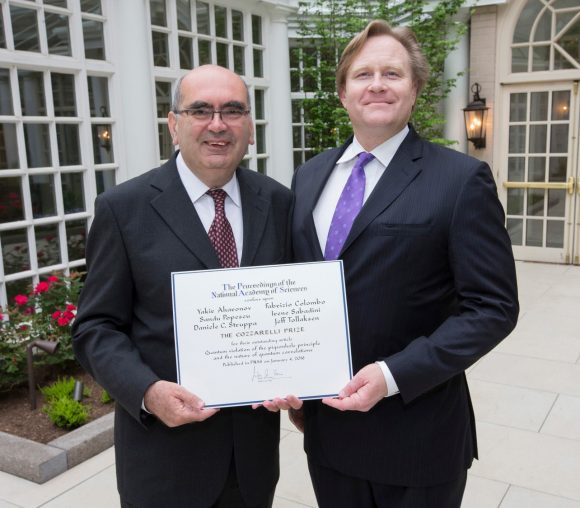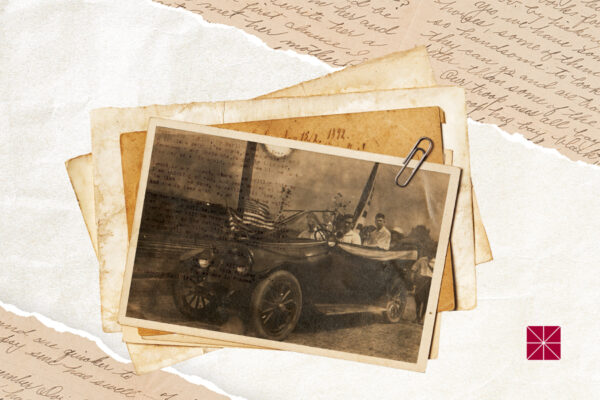Physicists from Chapman University’s Institute for Quantum Studies have received the prestigious Cozzarelli Prize for a paper published in 2016. The prize is awarded by the National Academy of Sciences for their article, Quantum violation of the pigeonhole principle and the nature of quantum correlations. The National Academy was founded by Abraham Lincoln.
The research was published by theProceedings of the National Academy of Sciences (PNAS) in January 2016. Published daily, PNAS is one of the world’s most-cited multidisciplinary scientific journals. It covers the biological, physical and social sciences and mathematics and publishes cutting-edge research reports, commentaries, reviews, perspectives, colloquium papers, and actions of the Academy. As such, all different areas of science compete for the Cozzarelli prize. Furthermore, out of the many dozens of different branches of physics, this is the first time the National Academy gave this prize to a branch called “foundations of physics” (where physics and philosophy overlap). Chapman’s Institute for Quantum Studies is considered as one of the leading such centers in the world in this field.
At the ceremony, about 1,000 scientists from all over the world attend representing categories such as biological sciences, engineering and applied sciences, biomedical sciences, behavioral and social sciences, and applied biological, agricultural, and environmental sciences.
“There were certainly more Nobel Laureates in a single room than I have ever seen before,” remarked Dr. Tollaksen.

The winning Chapman article introduced a new quantum phenomenon which the authors called the “quantum pigeonhole principle.” Prior to this breakthrough, the pigeonhole principle was a basic, common sense tenet of conventional wisdom. It states that if you put three pigeons in two pigeonholes then at least two of the pigeons must end up in the same hole. The new research violates this principle and demonstrates how to put an arbitrarily large number of particles in two boxes without any two particles ending up in the same box. The “Pigeonhole paper” won the prize for physical and mathematical sciences
“We couldn’t be more honored to be recognized by the National Academy for this work,” said Jeff Tollaksen, Ph.D., co-author of the article and co-director of Chapman’s Institute for Quantum Studies. “This work redefines how we think about the microscopic world. The laws governing the microscopic world, i.e. quantum mechanics, suggest that microscopic particles can be in many different places at the same time. Furthermore, the result of an experiment is not determined from the beginning. This opens the possibility that the future can be relevant to the past. The natural explanation for the unprecedented ability to cram an arbitrary number of pigeons (i.e. microscopic particles) into the same box without any 2 of them being in the same box (!) is that information from the future travels backward through time.”
The novel predictions of this prize winning paper have already been confirmed by papers co-authored by the group at Chapman’s Institute for Quantum Studies in collaboration with a group of physicists led by Yuji Hasegawa at the the Vienna University of Technology. The experiments verifying the quantum pigeonhole effect were conducted at the largest nuclear reactor in the world located in Grenoble, France.
“This is a surprising breakthrough,” says physicist and Institute member Paul Davies, Ph.D., of the Quantum Pigeonhole Effect. “It’s remarkable that it’s still possible to discover something fundamentally new about quantum mechanics, which has been around for nearly 100 years. Here we see a richer, more complex set of long-range correlations that nobody knew existed before.”
“The new results seem fascinating,” said Institute member Leonard Susskind, Ph.D., (the “father of string theory” and principle protagonist of Stephen Hawking). “I would guess that this new effect is a serious step in understanding quantum correlations.”
The Cozzarelli Prize is awarded annually for published PNAS papers “of outstanding scientific excellence and originality.” Authors on the paper were: Yakir Aharonov, Daniele Struppa , Fabrizio Colombo and Irene Sabadini of Politecnico di Milano; Sandu Popescu, whose principal university is Bristol University U.K., and Jeff Tollaksen – all members of Chapman’s Institute for Quantum Studies. The winners will be recognized during the National Academy of Sciences Annual Meeting Awards Ceremony on April 30, 2017, in Washington, D.C. Chapman acknowledges support (in part) for this project by the Fetzer Franklin Fund of the John E. Fetzer Memorial Trust.
About Chapman University’s Institute for Quantum Studies
Founded in 2012, Chapman University’s Institute for Quantum Studies (IQS) was created by co-directors Yakir Aharonov, Ph.D., and Jeff Tollaksen, Ph.D. IQS’ membership includes Nobel laureate Francois Englert, Ph.D., Nobel laureate David Gross, Ph.D., Nobel laureate Sir Anthony Leggett, Ph.D., FRS, Sir Michael Berry, Ph.D., FRS; Paul Davies, Ph.D.., among others, who meet annually in the vein of the world-famous physics Solvay conclave to discuss and collaborate on theoretical physics. IQS has many major publications including: Quantum Theory: A Two-Time Success Story
andQuantum Studies: Mathematics and Foundations. More about IQS can be found here:quantum.chapman.edu





Add comment